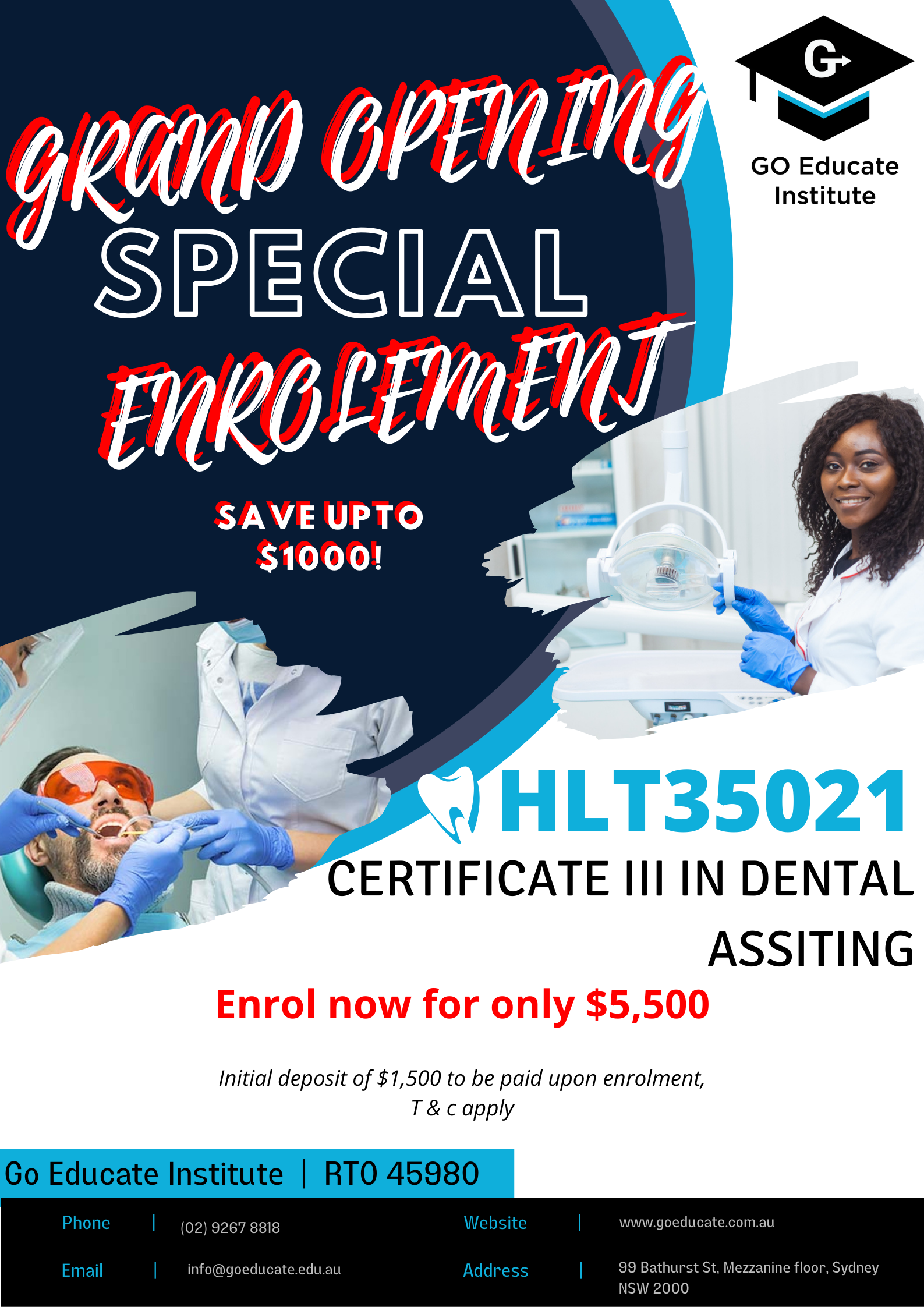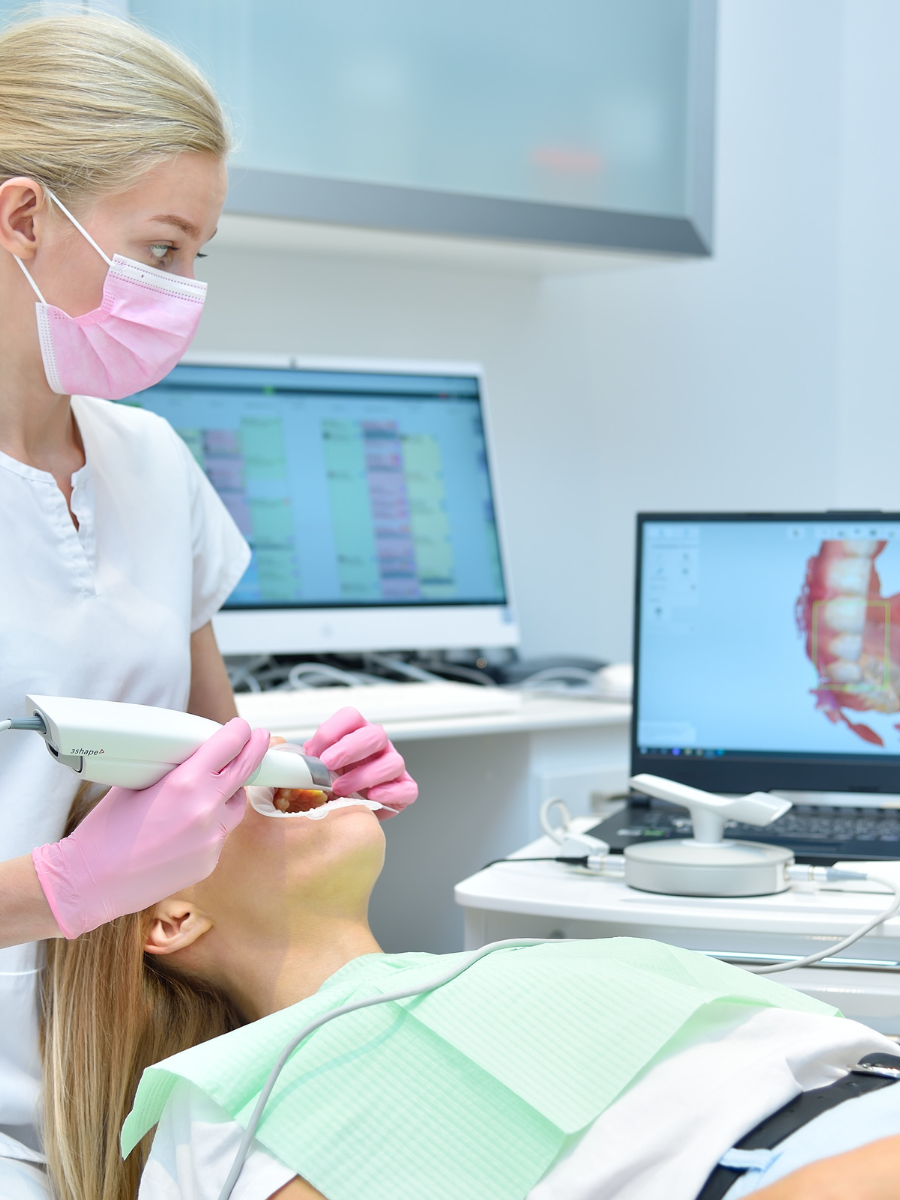OVERVIEW
Overview of HLT35021 Certificate III in Dental Assisting:
The HLT35021 Certificate III in Dental Assisting is a nationally recognized qualification that provides a solid foundation for individuals aspiring to become professional dental assistants. This program encompasses a range of essential skills and theoretical knowledge required to support dentists and dental specialists in delivering high-quality patient care.
By enrolling in this program, you will gain the knowledge, confidence, and industry experience required to become a valuable member of a dental team. Join us on this exciting journey and take the first step towards a rewarding future in dental assisting.

OUTCOMES
Key Program Outcome:
- Comprehensive Curriculum: Our Certificate III program covers all crucial aspects of dental assisting, including infection control, dental radiography, chairside assistance, oral health promotion, and administrative duties. You will gain a deep understanding of dental procedures, oral health concepts, and best practices in patient care.
- Hands-on Practical Training: We believe in learning by doing. Throughout the program, you will have access to our state-of-the-art dental facilities, where you will practice clinical skills and techniques under the guidance of experienced dental professionals. This practical training will enable you to develop the confidence and proficiency required for real-world dental settings.
- Industry-Relevant Experience: As part of the program, you will have the opportunity to participate in supervised workplace placement, allowing you to apply your knowledge and skills in a real dental practice. This hands-on experience will enhance your understanding of the dental profession and provide invaluable insights into the day-to-day responsibilities of a dental assistant.
- Professional Development: Our Certificate III program not only focuses on technical skills but also places emphasis on professional development. You will learn effective communication techniques, patient management strategies, and ethical considerations in dental practice. These skills will help you build strong relationships with patients and contribute to the smooth functioning of a dental team.
ENTRY REQUIREMENTS
During the pre-enrolment process, the training provider will gather information about your background, experience, and any relevant qualifications you may have. They will use this information to assess your suitability for the training program and determine if you have the necessary skills and capabilities to successfully complete the course.
Entry to this qualification is open to individuals who have the following:
Entry Age
- Minimum age of entry 18 years old
- Have successfully completed at least Australian high school year 10, or equivalent
Language, Literacy and Numeracy skills and additional support
- Have sound Language, Literacy and Numeracy skills (at least Year 10, or equivalent where suitability will be determined utilising Go Educate’s LLN Assessment Tool prior to enrolment*)
- Where candidates with disability or special needs are unable to complete an assessment task or activity, assessors must consider whether they are able to apply reasonable adjustment and adapt the assessment to enable the candidate to complete the task or activity.
Residency Status
- You will need to be a permanent Australian resident or equivalent
Vocational placement
- This qualification requires a minimum 350 hours of vocational placement. – Learners are expected to look for a Vocational Placement Provider on their own, and GoEducate Team will be checking the provider’s suitability and support.
Have basic computer skills
Computer Hardware and software requirements
For the online part of the course, you’ll need regular access to:
- Computer: Laptop or desktop computer with working speakers or headphone points.
- Internet: High-speed internet such as Broadband or ADSL, T1/T2, fibre optic (Dial-up access is not recommended).
- Windows: Operating system – Windows 8 or above.
- MAC: Operating system – OS X 10.14 Mojave or later.
- Internet Browser: Google Chrome, or Microsoft Internet Explorer 11.
- Software: Flash, Adobe Reader, Microsoft Word
- Office Equipment: Printer and scanner to print and upload some of your assessments.
- Mobile Phone with Video Capability or Video Camera: Some assessments in your course may require you to take and submit videos of you undertaking tasks for assessment.
During your study you’ll need to provide your teacher with the following evidence:
- National Police Check
- Working with Children Check (WWCC)
- Vaccination and health screenings
PATHWAYS
Completing Dental Assisting 3 can open up various pathways and opportunities for dental assistants. Here are a few potential pathways:
Specialisation: Dental Assisting 3 can serve as a stepping stone to further specialization in a specific area of dental assisting. You may choose to pursue additional training or education in areas such as orthodontics, oral surgery, endodontics, or pediatric dentistry. This can expand your career options and potentially lead to higher-paying positions or increased responsibility within specialized dental practices.
Dental hygiene or dental therapy: Provide a solid foundation for pursuing higher education in dental hygiene or dental therapy. These roles involve providing preventive and therapeutic dental care directly to patients, and the knowledge gained in Dental Assisting 3 can be valuable in transitioning to these fields.
Dental office management: Dental Assisting 3 may include components or elective units related to dental office management. This can enable you to develop skills in practice management, appointment scheduling, billing, and insurance coordination. With this knowledge, you may explore opportunities to work in dental office management roles or even consider opening your own dental practice in the future.
Upon successful completion of the HLT35021 Certificate III in Dental Assisting, you will be well-prepared to pursue various dental assisting roles in dental clinics, hospitals, specialty practices, and community health centers. Whether you choose to specialize in a particular field or further your education, this program serves as an excellent stepping stone for your dental career.
Continuous education : Graduates may also consider enrolling in HLT45021 Certificate IV in Dental Assisting
UNITS
This course covers a total of 10 units (8 core units and 2 elective units).
CORE UNITS
This unit describes the skills and knowledge required to communicate effectively with clients, colleagues, management and other industry providers.
This unit applies to a range of health and community service contexts where workers may communicate face-to-face, in writing or using digital media and work with limited responsibility under direct or indirect supervision.
This unit describes the skills and knowledge required to work respectfully with people from diverse social and cultural groups and situations, including Aboriginal and/or Torres Strait Islander people.
This unit of competency describes the performance outcomes, skills and knowledge required to prepare the dental surgery including equipment, instruments and materials, for dental procedures and assist the practitioner during dental procedures.
This unit applies to dental assisting work under the instruction and supervision of the dental practitioner.
This unit of competency describes the performance outcomes, skills and knowledge required to prepare patients for dental radiography. It also describes the skills and knowledge to process and mount conventional dental radiographs.
This unit applies to dental assisting work under the instruction and supervision of the dental practitioner.
This unit of competency describes the performance outcomes, skills and knowledge required for a dental assistant to assist the practitioner by managing appointments to suit the patient and the organisation, recording and reconciling payments, and maintaining patient records.
This unit applies to dental assistants who assist with administration in dental practice.
This unit describes the skills and knowledge required to follow organisational infection prevention and control procedures, including implementing standard and transmission-based precautions and responding to infection risks.
This unit applies to individuals working in health and direct client care contexts.
This unit describes the skills and knowledge required to clean, sterilise and package reusable medical devices and equipment.
This unit applies to workers in office based health practice settings such as general practitioner (GP) surgeries, dental practices and other environments where a limited range of sterilisation equipment may be available. They follow established procedures and work under general supervision.
This unit describes the skills and knowledge required for workers to participate in safe work practices to ensure their own health and safety, and that of others.
The unit applies to all workers who require knowledge of workplace health and safety (WHS) to carry out their own work, either under direct supervision or with some individual responsibility.
ELECTIVE UNITS
- *This course contains the unit, HLTAID011 Provide First Aid, which must be completed through an external RTO.
- Please note that the cost of this external training is not included in any of your course fees. Upon completion, you will need to submit a copy of your first aid certificate in order for us to process a Credit Transfer against this unit on your student record. If you have chosen your own third-party provider, you must submit a certified copy of your certificate.
This unit describes the skills and knowledge required to select and use software and organise electronic information and data.
The unit applies to those who use a limited range of practical skills with a fundamental knowledge of equipment use and the organisation of data in a defined context, under direct supervision or with limited individual responsibility.
DELIVERY OPTIONS
Delivery Schedule:
- 52 weeks (including holidays)
- 48 weeks (excluding holidays)
The course delivery includes four main delivery components:
- All activities contributing to the amount of training
- All activities facilitated by the trainers where direct support is provided to learners
These include but are not limited to:
- E-Learning through GoEducate’s LMS (includes reading materials with images, practice quizzes, etc)
- Online training sessions (minimum 6 hours/week)
- Face-to-face classroom training sessions (4 hours/week)
- Assessment feedback and coaching
- Online support
Beginner learners are required to attend face-to-face and online training sessions. Intermediate learners are only required to attend face-to-face training sessions. Training is optional for advanced learners and not offered to expert learners undertaking RPL or Credit Transfer.
All other non-assessment activities are independently undertaken by learners.
These activities are self-paced and self-directed.
Trainers will provide instructions about learning activities learners may undertake.
These include but are not limited to:
- Homework
- Research
These activities are typically recommended to beginners, optional for intermediate and advanced learners, and not offered to expert learners undertaking RPL or Credit Transfer.
All required assessment activities mapped to training package requirements. These activities may be completed in class or as homework.
These include but are not limited to:
- Written knowledge assessments
- Projects
- Tasks based on simulated scenarios/ case studies
- Observation via demonstration, presentation or role play
- Observation via workplace/vocational placement
- All assessment activities are mandatory for beginner, intermediate, and advanced learners.
For expert learners, taking the Knowledge Assessment is mandatory while RPL is required to satisfy the qualification’s practical requirements.
Learners are required to undertake a minimum of 350 hours of vocational placement within a suitable workplace in the industry.
Learners are expected to look for a Vocational Placement Provider on their own. GoEducate Team will be checking the provider’s suitability. Learners are recommended to look for their vocational placement providers as soon as enrolment is confirmed to allow sufficient time for GoEducate to check suitability and to make necessary preparations.
GoEducate may also refer students to its network providers, but there is no guarantee that there will be an available slot, so students are required to find a provider as explained above.
Go Educate will provide learners a workbook that will facilitate the required workplace assessments and allow the learner to complete the required vocational placement hours.
All learner cohorts are required to provide evidence of undertaking the minimum vocational placement or workplace hours. For learners undertaking RPL, instructions about the evidence to submit are provided in their RPL Kit.
Mode of delivery
- Blended learning ( with face to face and distant component)
- On the job vocational placement
Context for Assessment
- Training room/Institutional environment
- Simulated environment (virtual workplace)
- Work in industry/workplace (on the job)




